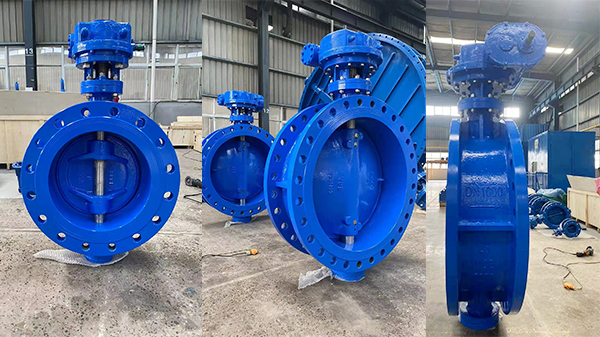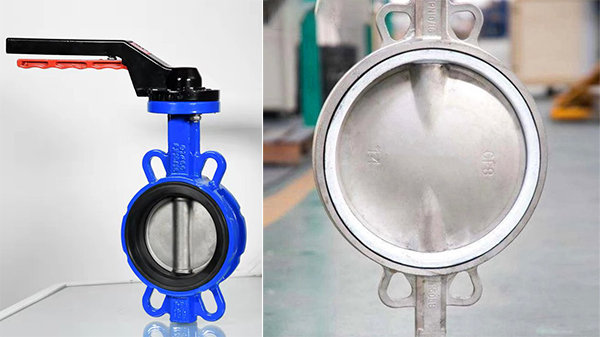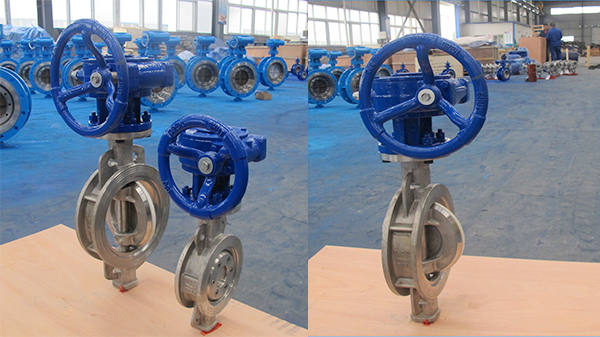- Gate valve
-
- DN1000 Extension stem double flange soft seal gate valveDIN F4 resilient seated gate valveDN450-1200 Resilient Seated Gate ValveDIN F5 resilient seated gate valveSocket connection soft seal gate valveUnderground cap soft seal gate valveBS5163 rising stem soft seal gate valveHard seal gate valveAPI slab Gate ValveStainless steel flange gate valveWafer knife gate valvePneumatic gate valveSoft seal gate valveExtension stem gate valveUL/FM fire protection groove ends gate valveRising stem forged steel gate valvecarbon steel gate valveStainless steel threaded gate valveDIN soft seal gate valveANSI soft sealing gate valve 200PSICast iron gate valveBS resilient seated gate valve
- Butterfly valve
-
- DN900 pneumatic triple eccentric hard seal butterfly valveD643H Triple Eccentric Butterfly ValveD343H Hard seal butterfly valveMulti standard EPDM seated butterfly valveSingle flange butterfly valveDN2000 Double eccentric butterfly valveFlange butterfly valveLug butterfly valveWafer butterfly valve with handleWorm gear operated butterfly valveWafer lined fluorine butterfly valveStainless steel wafer butterfly valveStainless steel flanged butterfly valveThree eccentric flange butterfly valvePneumatic flanged butterfly valvePneumatic wafer butterfly valveTriple eccentric butterfly valve wafer typeWafer butterfly valve ULC approvedInflatable seat butterfly valveHigh performance butterfly valveGrooved end butterfly valveElectric soft seal butterfly valveFlange fluorine lined butterfly valveHandle aluminum butterfly valveWorm Gear Aluminum Butterfly ValveFull PTFE lined butterfly valve wafer typeOne stem no-pin wafer butterfly valveMulti standard aluminum stem butterfly valveStainless Steel wafer Butterfly ValveAluminium handle operated lug butterfly valveLever Operated Flange Butterfly ValveButterfly valve stemButterfly valve discButterfly valve seat
- Ball valve
-
- DN1400 top-mounted eccentric semi-ball valveFlanged three-way ball valveFully welded ball valveNatural gas ball valveHigh platform flange ball valve1 PC ball valveFixed ball valvePTFE seat flanged ball valveMetal seat ball valveAPI 6D ball valve3 Piece ball valveFull Bore 3 way ball valve L-Port3 Way T-Port ball valve2PC Ball valve female thread stainless steel
- Globe Valve
-
- API Carbon Steel Globe ValveBellows Globe ValveStainless steel flange globe valveStainless steel thread S type globe valveStainless steel thread B type globe valveCast Steel Globe ValvePiston Globe ValveWCB Carbon Steel Globe Check Valveelectric motorized control stainless steel SS316 globe valveBrass Globe ValveCryogenic Globe valveHT200 Globe ValveThreaded Stainless Steel Globe ValveGG25 Globe ValveANSI API Cast Steel And Stainless Steel Globe valve
- Check valve
-
- Rubber seal check valveDN800 Slow closing check valveDN800 Rubber Disc Check ValveButterfly Buffering Check Valvecheck valve with counter weightSilent Check ValveWCB Swing check valveSwing Check ValveSingle Chip Check Valve H74WStainless Steel Wafer Check ValveSwing Start Check ValveFoot check valveAPI Swing Check ValveDIN Flange check valveSingle plate check valveLifting Check ValveBottom ValveHammer Diminish Noises Check ValveWafer Check ValveWafer dual plate check valve
- Control valve
-
- Static Balancing ValveCage Guided Sleeve Globe Control ValveDN1000 Piston Flow Regulating ValveDN1600 Electric Actuator Flow Regulating ValvePneumatic Flanged Butterfly ValvePneumatic Wafer Butterfly ValveAngle Seat ValvePneumatic gate valveElectric three-way control valveElectric sleeve control valve
- Water Meter
-
- Vertical Type Water MetersStainless steel threaded water meterPiston water meterPlastic water meterMore flow rotor dry water meterspiral vane flange water meterCI wotlman water meter with pulse outputLXCLG(R) Vertical removable element woltman cold (hot) water meterSingle flow rotor dry water meterPrepaid Token Water MeterElectromagnetic flowmeterRotary Piston Liquid Sealed Water MeterRotary Piston Liquid Sealed Water Meter
- Air valve
-
- Double ball exhaust valveDoubleair Air Valve SaudiDoubleair Air Valve Southeast AsiaDoubleair Air Valve South AmericaDouble Air ValveThreaded Air ValveSingle Air ValveTriple Functions Air ValveAutomatic Air Release ValveAutomatic release valveAutomatic exhaust valveComposite Exhaust Air ValveBrass exhaust valveDouble Ball Air Valve
- Pipe Repair & Coupling
-
- Flexible Multi-Function Pipe Coupling ZFJ-SSS Semi-Circle Pipe Repair Clamp SJW-HDuctile Iron Band Repair ClampStainless Steel Band Repair ClampDouble-Section Pipe Repair CouplingFolding Type Pipe RepairSingle-Section Multi-Function Pipe Coupling MF-SGear-Ring Type Multi-Function Pipe Coupling GR-SZBW Damping Corrugated Hose
- Dismantling Joint
-
- VSSJAFC(CC2F) Detachable Flange Transmission JointVSSJA-2(B2F) Double Flange Limited Expansion JointVSSJA-1(BF) Single Flange Limited Expansion JointVSSJA(AF) Flange Loose Expansion JointJGD-B Threaded Rubber JointZBW Damping Corrugated HoseKXT-S Flexible Dual-Spherical Rubber JointKXT Rubber Soft JointFlange Adaptor
The difference between centerline, double and triple eccentric butterfly valves
Centerline butterfly valve is that the shaft center of the valve stem, the center of the disc and the center of the body are in the same position. The structure is simple and the manufacture is convenient. Common rubber-lined butterfly valves belong to this category. The disadvantage is that the butterfly plate and the valve seat are always in a state of extrusion and scraping , so the resistance distance is large and the wear is fast. In order to overcome extrusion and scratching and ensure the sealing performance , the valve seat is basically made of elastic materials such as rubber or PTFE .
But it is also limited by temperature in use , which is why traditionally people think that butterfly valves are not resistant to high temperature.
Double eccentric butterfly valve
On the basis of the centerline butterfly valve, the most widely used double eccentric butterfly valve is further improved and formed. Its structural feature is that the shaft center of the valve stem deviates from the center of the disc and the center of the body. The effect of double eccentricity enables the disc to break away from the valve seat immediately after the valve is opened , which greatly eliminates unnecessary excessive extrusion and scratching between the disc and the valve seat . The opening resistance distance is reduced, the wear is reduced , and the valve seat life is improved.
The scraping is greatly reduced , and at the same time, the double eccentric butterfly valve can also use a metal valve seat , which improves the application of the butterfly valve in the high temperature field.
However, because its sealing principle is a positional sealing structure , that is, the sealing surface of the disc and the valve seat is in line contact , and the elastic deformation caused by the disc pressing the valve seat produces a sealing effect , so the closed position is required to be high , and the pressure bearing capacity is high. low .
This is why traditionally it is believed that butterfly valves are not resistant to high pressure and have large leakage.

Triple eccentric butterfly valve
To withstand high temperature , a hard seal must be used , but the amount of leakage is large; to zero leakage , a soft seal must be used , but it is not resistant to high temperature. In order to overcome the contradiction of the double eccentric butterfly valve , the butterfly valve was eccentric for the third time. The structure is characterized in that the conical axis of the sealing surface of the butterfly plate is deviated from the cylinder axis of the body while the position of the double eccentric valve stem is eccentric . That is to say , after the third eccentricity , the sealing section of the disc is no longer a true circle , but an ellipse .
The shape of the sealing surface is also asymmetrical , one side is inclined to the centerline of the body, and the other side is parallel to the centerline of the body.
The biggest feature of this third eccentricity is that the sealing structure has been fundamentally changed , and it is no longer a positional seal , but a torsion seal .
That is, it does not rely on the elastic deformation of the valve seat , but completely relies on the contact surface pressure of the valve seat to achieve the sealing effect .
Therefore, the problem of zero leakage of the metal valve seat is solved in one fell swoop , and because the contact surface pressure is proportional to the medium pressure , the high pressure and high temperature resistance is also easily solved.









